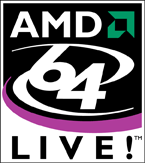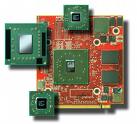Platform Guide: Laptops
Centrino

When Intel got serious about laptops and wireless, they got serious about laptops and wireless. The Centrino branding was launched as wireless networking was beginning to really take off. Centrino was marketed on two basic pillars: wireless networking and battery life. At its launch, many laptops still lacked wireless networking support. And no mainstream laptops could match its battery life, which was nearly double what many competing products could manage. The original iteration of Centrino specified one of Intel's Pentium M processors, one of Intel's chipsets, and one of Intel's PRO/Wireless 802.11b ("Wi-Fi") or a/b adapters. It would later go through more versions, with 3 different codenames.
Carmel

The original. Notably, it initially did not support 802.11g (which was still in draft form when Carmel was finalized).
Requires: Pentium M Banias processor, Intel 855 (Montara/Odem) chipset, and Intel PRO/Wireless 2100 (802.11b) or 2100AB (802.11a and 802.11b) wireless adapter. Later the PRO/Wireless 2200BG (802.11b/g) adapter would be added as an option.
Sonoma
Added support for faster Front Side Bus speeds, as well as new specifications like SATA, DDR2, and PCI-Express that had been introduced on the equivalent desktop chipset.
Requires: Pentium M Dothan processor, Intel Mobile 915 (Alviso) chipset, and Intel PRO/Wireless 2200 (802.11b/g) or 2915 (802.11a/b/g) wireless adapter.
Napa
Brought the Core Solo Yonah into the fold. If the Core 2 Solo Merom is substituted for the Core Solo Yonah, you have Napa Refresh.
Requires: Core Solo Yonah processor, Intel Mobile 945 (Calistoga) chipset, and Intel PRO/Wireless 3945ABG (802.11a/b/g) wireless adapter.
Centrino Atom

Menlow
Combining the Atom Silverthorne processor with Intel's System Controller Hub (a single-chip chipset), Centrino Atom is easily the lowest-power incarnation of Centrino. Intel intends to market it toward the "mobile internet device" category of products (in short, devices similar to the iPod Touch).
Requires: Atom Silverthorne processor, Intel System Controller Hub, any wireless communications (Wi-Fi and/or cellular connectivity).
Centrino Duo

Napa
Centrino Duo is not fundamentally different from the original Centrino brand, but it has one slight twist: it is built around a dual core processor rather than a single core one. If the Core 2 Duo Merom is substituted for the Core Duo Yonah, you have Napa Refresh.
Requires: Core Duo Yonah processor, Intel Mobile 945 (Calistoga) chipset, and Intel PRO/Wireless 3945ABG (802.11a/b/g) wireless adapter.
Santa Rosa
New processors, new chipsets, better performance. Now with Draft-N wireless networking.
Requires: Core 2 Duo Merom (or Penryn for Santa Rosa Refresh), Intel GM965 or PM965 chipset, Intel 4965AGN (Kedron) (Wireless-A, B, G, and Draft-N) wireless networking chipset.
Centrino Pro

Extremely similar to the Centrino Duo Santa Rosa, but with Intel Active Management Technology, Trusted Execution Technology, and Intel VT. This would, in effect, morph into Centrino with vPro.
Requires: Core 2 Duo Merom (or Penryn for Santa Rosa Refresh), Intel GM965 or PM965 chipset, Intel 4965AGN (Kedron) (Wireless-A, B, G, and Draft-N) wireless networking chipset.
Centrino with vPro

Suppose you took one of the more recent iterations of Centrino, and smashed it together with vPro. This is what you would get: a mobile, wireless, virtualized, remotely-manageable platform. Like the desktop-borne vPro, Centrino with vPro requiers Intel's Active Management Technology and Intel-VT virtualization. This platform was codenamed Montevina.
Requires: Core 2 Duo processor with AMT, Intel-VT, and 800 MHz Front-Side Bus; Intel 965 Express chipset; Intel 82566DC (Nineveh) Gigabit Ethernet networking chipset; Intel 4965AGN Wireless A/B/G/Draft N networking chipset.
Centrino 2

A new motherboard chipset and a processor with a faster Front-Side Bus are meant to provide some extra juice to Intel's storied mobile platform. Intel also packed in support for what it calls Switchable Graphics, which (like Hybrid SLI or Hybrid Crossfire) allows a laptop to combine an integrated Graphics Processing Unit (GPU) and a discrete GPU to work together, then reduce power usage of the discrete GPU under light loads (it is not yet clear if it can be shut off completely).
Requires: Core 2 Duo processor with 1066 MHz Front-Side Bus (and 45 nm), Intel Mobile GM45 Express chipset, Intel Wireless Link 5000 series networking (Wireless-N), Intel 82567LM Gigabit Ethernet networking chipset.
Centrino 2 with vPro

[Centrino 2 with vPro homepage]
Centrino 2 once again combined with vPro. Or an evolution of Centrino with vPro, if you prefer to think of it that way.
Requires: Core 2 Duo processor, Intel GS45 motherboard chipset, Intel Wireless Link 5000 series networking (Wireless-N), Intel 82567LM Gigabit Ethernet networking.
Live!

Just like the desktop platform, but more portable.
Requires: Turion 64 X2 processor.
Puma

At last, a direct challenge from AMD to Intel's Centrino. Puma combines AMD's laptop-optimized Griffin processors with the new RS780M chipset, then throws in everything but the kitchen sink. Split power planes, variable-width HyperTransport links, PowerXpress, and just about every feature AMD could come up with to extend battery life. As usual, AMD doesn't care who handles your networking chipset (since they, unlike Intel, do not make any networking chipsets). The official name for the platform, it seems, is "Next Generation AMD Notebook Platform for Home".
Requires: Turion X2 Ultra, Turion X2, or Sempron processor (Griffin core); RS780M chipset.
Viiv

Just like the desktop platform, but more portable. Interestingly, word from on high is that a laptop is not allowed to be both Centrino (or Centrino Duo) and Viiv certified.
Requires: Core Duo processor, Intel Mobile 945G chipset, Intel High Definition Audio (Azalia), Intel Matrix Storage (RAID 0, 1, 5, 10), Intel Quick Resume (simulated instant on/instant off), and an Intel networking chipset.
Viiv, Core 2 variant

Very much like the Core 2 version of Viiv seen on the desktop, but with a different processor and motherboard chipset. Somewhat surprisingly, and perhaps by omission, Intel does not list any requirement for wireless networking.
Requires: Core 2 Duo processor (T9500, T9300, T8300, T8100), Intel GM965 or PM965 motherboard chipset, Microsoft Windows Vista Home Premium or Ultimate, NCQ-enabled SATA hard drive, Intel High Definition Audio (Azalia), Intel Matrix Storage (RAID 0, 1, 5, 10), and an Intel networking chipset.
Yamato
AMD apparently decided to get in on Intel's act, and so is launching the Yamato platform. Yamato's chief feature is a dual core Turion 64 X2 processor. It is otherwise very, very open. In fact, it doesn't specify a chipset that must be used, unlike Intel's platforms. The current reference design is built on an nVidia nForce chipset, though ATI reportedly has something in the works. By launch, several manufacturers are expected to have chipsets available. Yamato is meant to be a Centrino Duo killer, boasting two cores, strong performance, and good battery life. But AMD's historic weakness in the laptop market (and the haphazard array of chipsets) may cut into that.
The above was written in 2006. As of 2008, Yamato appears to have fallen off the face of the Earth: nothing on AMD's website, and no apparent press mentions in 2 years. You could be forgiven for thinking it had turned into vaporware. Or perhaps was axed to make way for Puma.
Requires: Turion 64 X2 processor.
